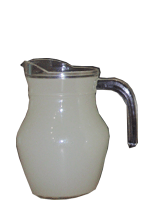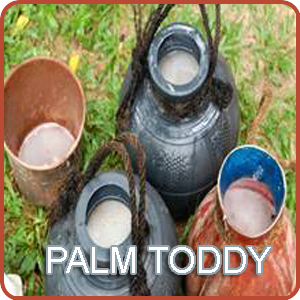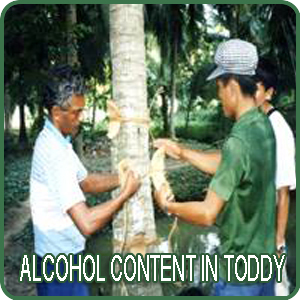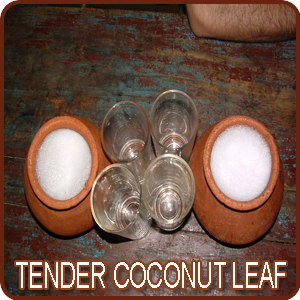 HISTORY OF TODDY DRINK
HISTORY OF TODDY DRINK
The history of cane and its associated products in India is traced back to the 2nd century AD. The cane furniture of India is characterized with features like lucidness and comfort with extreme beauty or aesthetic appeal. Cane is noted for its special property in spite of being quite strong it can also be bendable easily and thus making it ideal for furniture making. In today's scenario cane is seen used in making all types of furniture like chairs, tables, sofas, stools, shoe racks, bookshelves, cabinets, beds, couches, recliners, etc. The cane products in India are available at different price ranges suiting the budget of all class of people. The North East state in India, Assam is noted for its rich sylvan resources and its forest areas are stocked with bamboos and canes of various species. Cane and bamboo having a wide variety of potential forms an indispensable part of the lifestyle and economy of the people of Assam.
 TODDY FROM COCONUT
TODDY FROM COCONUT
Toddy is nothing but the sap got from incising the clusters of the coconut mostly not being fermented. Later when kept aside for itself to be fermented it is called as palm wine and this when later distilled gives the product known as arrack. Kerala toddy is also referred by the foreigners as coconut vodka. It is estimated that a highly maintained tree has the capacity to produce at least 300 liters of toddy per year and also as the tree gets older, say a 40 year old tree can easily produce about 400 liters of palm toddy. The coconut palm tree belongs to the Arecaceae or the palm family and is supposed to be the only recognized species in the Cocos genus and the term coconut not only refers to the fruit but it includes the palm and the seed too. The term is derived from 16th-century Portuguese and Spanish coco, meaning "head" or "skull", from the three indentations on the coconut shell that resemble facial features.
 PALM WINE OR THE TODDY MANUFACTURED IN KERALA
PALM WINE OR THE TODDY MANUFACTURED IN KERALA
The palm wine or the toddy manufactured in Kerala have accorded to the serious risk of extinction of some palm varieties like Chilean wine palm (Jubaea chilensis).Whereas this has also benefitted in the area of palm wine production by small holders and individual farmers may promote conservation as palm trees become a source of regular household income that may economically be worth more than the value of timber sold. The toddy or the palm wine got from the fresh sap in Kerala is mainly served in the name of neera or padaneer which is a sweet and non-alcoholic beverage. When this sap is left to ferment by itself and not the extent of as strong as a wine then it is known as kallu. Kallu is supposed to be drunk immediately after fermentation for as the duration of the time increases then it becomes more sour and acidic day by day. The palm toddy has a very short shelf life and it tastes more like vinegar. But of course can be refrigerated for a couple of days to extend its life.
 PRODUCTS OF PALM TODDY INCLUDE PALM JAGGERY
PRODUCTS OF PALM TODDY INCLUDE PALM JAGGERY
Further if one wishes the drink is brewed by adding spices and which then gives a very unique taste. Products of palm toddy include palm jaggery, vinegar, arrack and yeast.Apart from being consumed as a beverage, palm wine or the toddy plays other role in many ceremonies wherein many African countries it is offered to the guests at times of weddings, birth celebrations and funerals. It is also most of the time mixed with different medicinal herbs to treat a number of physical ailments. There are rituals associated in different parts of the country like as a matter of respect a small amount of toddy is always spilled on the ground before men sit for the drink sessions. Both men and women drink the toddy where mostly women drink it in less public venues. There are some customs followed by a particular community where the groom when going into his in-laws place is supposed to carry palm wine of a specified gallon.
 PEOPLE OF KERALA ALSO USE TODDY AS A LEAVENING AGENT
PEOPLE OF KERALA ALSO USE TODDY AS A LEAVENING AGENT
The people of Kerala also use toddy as a leavening agent for a traditional food of Kerala known as vellai appam. Toddy when mixed with rice dough and left overnight it helps in fermentation and expansion of the dough giving it a rise and thus when prepared it is very soft. The fermented palm toddy is also ingested as part of diet in fair quantity by the small pollinating mammals like the Southeast Asian pen-tailed tree shrew. The inflorescences of the bertam palm contains populations of yeast which ferment the nectar in the flowers to up to 3.8% alcohol (average: 0.6%). The tree shrews metabolize the alcohol very efficiently and do not appear to become drunk from the fermented nectar. The palm toddy of Kerala is also used in different parts of other states like Karnataka and Goa for the preparation of a soft variety of Sanna. The government of Kerala has issued license by the excise department to the toddy shops.
 THE ALCOHOL CONTENT IN TODDY IS ABOUT 8.1%
THE ALCOHOL CONTENT IN TODDY IS ABOUT 8.1%
This is more of an industry today in Kerala where there are nearly 50,000 workers employed under the labor department with the welfare board. People of Kerala consider toddy more as a natural alcohol and health drink. The alcohol content in toddy is about 8.1% and most of the women living in central Kerala prefer having palm toddy. Toddy tapped from the coconut or the palm trees are usually done by professional climbers and only then sold to shops where after which it goes to the drinkers. A bottle with a capacity of 750ml of toddy is around Rs.45. The state of Kerala has around 5000 toddy shops and is considered more as a refreshing drink by the natives. A household which gives a coconut tree for toddy tapping is paid an annual amount fixed by negotiations between the tapper and owner. But this is not same for palm trees, as the owner of the tree gets the full quantity of toddy collected.
 TODDY TAPPING DONE IN A LARGE SCALE
TODDY TAPPING DONE IN A LARGE SCALE
Then the bark goes into further steps of processing where it is made into thin strands and then caning takes place. In the process of caning the thin strands are woven to make caned furniture and other related products. The material used in this art is cane and the process in known as caning and the outcome is the cane furniture. Cane products which are more eco- friendly is no longer an outdoor decor or shows a rusty living but are made more trendy for contemporary living. Even the unrefined natural bamboo furniture, milled and laminated bamboo with a darker stained finish is leading the way as the new look of eco- furniture. When compared to oak, cane is much stronger and is not affected by water and gives an aesthetic look which is proved to be a sustainable natural resource and a pioneer material in the movement for eco-friendly furniture. The growth rate of bamboo is quite fast and can be harvested continuously for many years
 INITIAL PROCESS IN THE MAKING OF CANE PRODUCTS
INITIAL PROCESS IN THE MAKING OF CANE PRODUCTS
The professionals who are involved in toddy tapping are in thousands in the state and they mainly come from a specific community, Hindu Ezhava.Though the government came up a number of times in banning toddy it really didn't work for it was likely to affect livelihood of thousands. As already discussed the sweet toddy is a non alcoholic drink tapped from coconut and it is in the unfermented form and is more popularly known as naira. The Kerala government has appointed a committee which set rules and regulations for toddy tapping in the state. This committee has also studied the possibilities and prospects of starting neera business in Kerala. Apart from this the Coconut development board is looking forward for the neera production units which will in turn enhance the coconut sector. The technological advances made in the processing and packaging of Neera ensure that it remains a zero alcoholic drink.
 PROCESS OF TODDY TAPPING
PROCESS OF TODDY TAPPING
It also suggested starting neera tapping and production, processing and packaging under the auspices of the Federations of Coconut Producers Societies. Nearly 1500 trees have been selected in each district of the Kerala state for neera tapping. Besides, neera technicians would be given membership in the Toddy Tappers Welfare Fund Board.Toddy tapping cannot be done by anybody in fact even the owner of the tree for it is considered to be illegal. The coconut palm tree is leased from the owner and license is given for collection of toddy. Once the palm tree is selected the toddy tappers using a coir rope tied with coconut husks at every interval of two feet which gives the tree a ladder. Initially coir ropes were also used to climb the tree but it is generally avoided because when a tree is climbed thrice a day, then in course of time the tree trunk becomes smooth like a tile and will not help in climbing up and down. The un-opened buds of the palm flower are cut where at least 95% is left remaining on the tree. The bud is then beaten and pound with hammer resulting in a swollen bud.
 THE COLLECTION OF TODDY
THE COLLECTION OF TODDY
Only in case of infection a new bud cannot be used but however a good bud will last at least for two months. A tender coconut leaf or a rope is used to bind the cut bud and then a paste made from the taali leaf is used for application on the cut portion which keeps the bud away from bacterial infection. This paste also makes the bud ooze and also not allowing it to dry and heal. However some people also use a kind of clay instead of the paste which is generally not recommended but this aid in increased extraction of the toddy and also imparts a slightly different taste. The beating of the new flower bud takes place over a period of a week, after which the sap starts oozing out from the flower and can be collected twice a day. The same steps follow repeatedly. Now a mud vessel is fitted in such a way that it covers half of the bud and the sap directly drips into the vessel.
 MUD VESSELS ARE ALSO AT TIMES COVERED WITH A GUNNY SACK
MUD VESSELS ARE ALSO AT TIMES COVERED WITH A GUNNY SACK
These mud vessels are also at times covered with a gunny sack to prevent insects getting into the vessel. The Chethukaran or the toddy tappers have to climb the tree at least thrice a day where in the morning and in the evening they climb to collect toddy and once in the afternoon to slow down the sap from dripping as it helps the palm to recover. Since lot of insects get attracted to this drink, the toddy tappers have to be careful when they do the tapping. Each palm tree has the capacity to produce 1 to 1.5 liters of toddy daily. Once it is collected some people add either a piece of white pumpkin or an edible lime only to prevent further fermentation of the toddy so that it can be fresh for a long time. At the rise of the sun the toddy is automatically fermented with an alcohol content of about 8% on the third day of extraction. After the third day the process of acetic fermentation starts resulting in the reduction of the alcohol content. Palm toddy is sedative, it is also a mild laxative and also stomachic.
 HISTORY OF TODDY DRINK
HISTORY OF TODDY DRINK TODDY FROM COCONUT
TODDY FROM COCONUT  PALM WINE OR THE TODDY MANUFACTURED IN KERALA
PALM WINE OR THE TODDY MANUFACTURED IN KERALA PRODUCTS OF PALM TODDY INCLUDE PALM JAGGERY
PRODUCTS OF PALM TODDY INCLUDE PALM JAGGERY
 PEOPLE OF KERALA ALSO USE TODDY AS A LEAVENING AGENT
PEOPLE OF KERALA ALSO USE TODDY AS A LEAVENING AGENT THE ALCOHOL CONTENT IN TODDY IS ABOUT 8.1%
THE ALCOHOL CONTENT IN TODDY IS ABOUT 8.1% 
 TODDY TAPPING DONE IN A LARGE SCALE
TODDY TAPPING DONE IN A LARGE SCALE INITIAL PROCESS IN THE MAKING OF CANE PRODUCTS
INITIAL PROCESS IN THE MAKING OF CANE PRODUCTS PROCESS OF TODDY TAPPING
PROCESS OF TODDY TAPPING  THE COLLECTION OF TODDY
THE COLLECTION OF TODDY 
 MUD VESSELS ARE ALSO AT TIMES COVERED WITH A GUNNY SACK
MUD VESSELS ARE ALSO AT TIMES COVERED WITH A GUNNY SACK 

